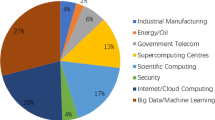Abstract
With the significant advancement in emerging processor, memory, and networking technologies, exascale systems will become available in the next few years (2020–2022). As the exascale systems begin to be deployed and used, there will be a continuous demand to run next-generation applications with finer granularity, finer time-steps, and increased data sizes. Based on historical trends, next-generation applications will require postexascale systems during 2025–2035. In this study, we focus on the networking and communication challenges for post-exascale systems. Firstly, we present an envisioned architecture for post-exascale systems. Secondly, the challenges are summarized from different perspectives: heterogeneous networking technologies, high-performance communication and synchronization protocols, integrated support with accelerators and field-programmable gate arrays, fault-tolerance and quality-of-service support, energy-aware communication schemes and protocols, softwaredefined networking, and scalable communication protocols with heterogeneous memory and storage. Thirdly, we present the challenges in designing efficient programming model support for high-performance computing, big data, and deep learning on these systems. Finally, we emphasize the critical need for co-designing runtime with upper layers on these systems to achieve the maximum performance and scalability.
Similar content being viewed by others
References
ASCAC Subcommittee on Exascale Computing, 2010. The Opportunities and Challenges of Exascale Computing. https://science.energy.gov/media/ascr/ascac/pdf/reports/Exascale_subcommittee_report.pdf
Biswas R, Lu XY, Panda DK, 2018. Accelerating tensorFlow with adaptive RDMA–based gRPC. 25th IEEE Int Conf on High Performance Computing, Data, and Analytic.
Cui YF, Moore R, Olsen K, et al., 2007. Enabling verylarge scale earthquake simulations on parallel machines. In: Shi Y, van Albada GD, Dongarra J, et al. (Eds.), Computational Science. Springer Berlin Heidelberg, p.46–53.
Energy Government, 2011. Workshop on Terabits Networks for Extreme Scale Science. https://science.energy.gov//media/ascr/pdf/programdocuments/docs/Terabit_networks_workshop_report. pdf
Graham RL, Bureddy D, Lui P, et al., 2016. Scalable Hierarchical Aggregation Protocol (SHArP): a hardware architecture for efficient data reduction. Proc 1st Workshop on Optimization of Communication in HPC, p.1–10. https://doi.org/10.1109/COMHPC.2016.006
Intel, 2016. Intel Omni–Path Architecture Driving Exascale Computing and HPC. https://www.intel.com/content/www/us/en/highperformance–computing–fabrics/omni–path–drivingexascale–computing.html
Li RZ, DeTar C, Gottlieb S, et al., 2017. MILC code performance on high end CPU and GPU supercomputer clusters. http://cn.arxiv.org/abs/1712.00143
Lu XY, Shankar D, Gugnani S, et al., 2016. Highperformance design of Apache Spark with RDMA and its benefits on various workloads. Proc IEEE Int Conference on Big Data, p.253–262. https://doi.org/10.1109/BigData.2016.7840611
Mellanox BlueField, 2017. Multicore System on Chip. http://www.mellanox.com/related–docs/npu–multicoreprocessors/PB_Bluefield_SoC.pdf NVMe Express, 2016. NVMe over Fabrics. http://www.nvmexpress.org/wp–content/uploads/NVMe_Over_Fabrics.pdf
ORNL, 2018. Summit: America’s Newest and Smartest Supercomputer. https://www.olcf.ornl.gov/summit/
Rahman MWU, Lu XY, Islam NS, et al., 2014. HOMR: a hybrid approach to exploit maximum overlapping in MapReduce over high performance interconnects. Proc 28th ACM Int Conf on Supercomputing, p.33–42. https://doi.org/10.1145/2597652.2597684
Rajachandrasekar R, Jaswani J, Subramoni H, et al., 2012. Minimizing network contention in Infini–Band clusters with a QoS–aware data–staging framework. IEEE Int Conf on Cluster Computing, p.329–336. https://doi.org/10.1109/CLUSTER.2012.90
Sarvestani AMK, Bailey C, Austin J, 2018. Performance analysis of a 3D wireless massively parallel computer. J Sens Actuat Netw, 7(2):18. https://doi.org/10.3390/jsa.7020018
Shankar D, Lu X, Islam N, et al., 2016. High–performance hybrid key–value store on modern clusters with RDMA interconnects and SSDs: non–blocking extensions, designs, and benefits. IEEE Int Parallel and Distributed Processing Symp, p.393–402. https://doi.org/10.1109/IPDPS.2016.112
Subramoni H, Lai P, Sur S, et al., 2010. Improving application performance and predictability using multiple virtual lanes in modern multi–core InfiniBand clusters. Int Conf on Parallel Processing.
Author information
Authors and Affiliations
Corresponding author
Additional information
Project supported by the National Science Foundation of the USA (Nos. IIS-1447804 and CNS-1513120)
Rights and permissions
About this article
Cite this article
Panda, D., Lu, XY. & Subramoni, H. Networking and communication challenges for post-exascale systems. Frontiers Inf Technol Electronic Eng 19, 1230–1235 (2018). https://doi.org/10.1631/FITEE.1800631
Received:
Revised:
Accepted:
Published:
Issue Date:
DOI: https://doi.org/10.1631/FITEE.1800631
Key words
- Networking
- Communication
- Synchronization
- Post-exascale
- Programming model
- Big data
- High-performance computing (HPC)
- Deep learning
- Quality of service (QoS)
- Accelerator




